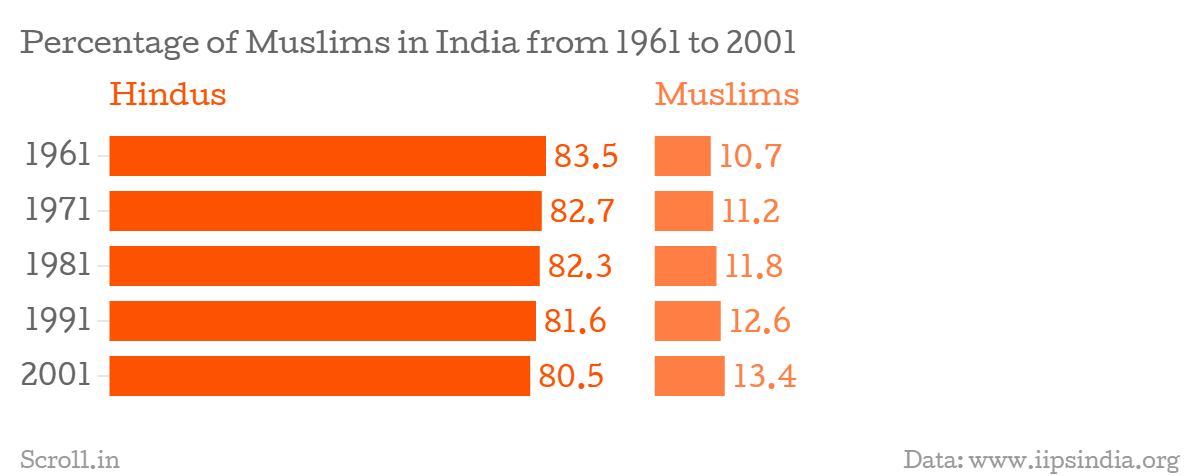The Rashtriya Swayamsevak Sangh – which organised the contentious Agra conversions and has now planned a similar ceremony in Aligarh on Christmas – has often peddled the theory that Hindus in India are in danger of being outnumbered by Muslims. The fundamentalist group claims that the ancestors of members of all minority groups were Hindu, and so that if Indian Muslims and Christians are not brought back to their original faith, Hindus will become a minority.
By way of evidence for this theory, Hindutva organisations cite census data: over the past four decades, there has been a slow increase in the population of Muslims and a slow decline in that of Hindus.
Numerically, the population of Hindus grew from 336 million in 1961 to 827 million in 2001. The Muslim population, meanwhile, grew from nearly 47 million to 138 million during the same time period. (The religious data from the 2011 census has not yet been released).

The percentage of Hindus and Muslims in relation to the total population has seen a very gradual change: in four decades, the proportion of Hindus declined by three percentage points, and that of Muslims has risen by 2.7 percentage points.

It’s just natural
To proponents of Hindutva, this three percentage point slip is reason enough to blame the minority community for producing too many children, to claim that Muslim men are waging a "love jihad" to woo Hindu women in order to convert them to Islam, and to announce the need for "homecoming" rituals. Muslims (and Christians), they claim, have been making concerted attempts to convert Hindus to Islam, so a ghar wapasi is a means to restore the balance.
But demographers say that this negligible change in the composition of India's population is unconnected to the politics of conversion.
“Conversions take place in very small numbers in comparison with the huge population of this country,” said Faujdar Ram, director of the International Institute for Population Sciences in Mumbai, and co-author of a paper on religious demographics [PDF].
“The slight increase in the Muslim population over four decades is just natural, and can perhaps be attributed to more fertility in that group,” he said.
Mortality, not fertility
The image of the fertile, lower-class Muslim woman who has too many children has become almost a stereotype, but a study by Bristol University reveals that there is another, oft-overlooked aspect that probably explains the gradual increase in Muslim population.
The study points out that even though “Muslims have, on average, lower socio-economic status, higher fertility and shorter birth intervals,” Muslim children face lower mortality risk than Hindu children.
Researchers have attributed this puzzling trend to a range of different factors: Muslim mothers are less likely to work compared with Hindu mothers, which has a positive impact on children’s health; Muslims tend to live in urban areas or large villages, where there is better access to healthcare; Muslims are less likely to practice female infanticide.
No fixed figures
Five Indian states already have anti-conversion laws to prevent forced conversions – Odisha, Madhya Pradesh, Chhattisgarh, Gujarat and Himachal Pradesh. In these states, all conversions have to be reported to district authorities, except the ones that take place within "indigenous religions" such as Hinduism, Buddhism, Sikhism or Jainism.
But even in the states where conversions are supposed to be made official, faith cannot be completely regulated. As this report indicates, religious faith is fluid, and in areas caught in the politics of conversion, individuals often practice a mix of different religious traditions and rituals.
“We cannot really be sure of how many people are being converted into which religion,” said civil rights activist John Dayal.










